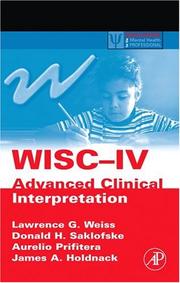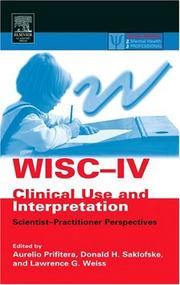| Listing 1 - 10 of 16 | << page >> |
Sort by
|

ISBN: 1280707569 9786610707560 0080466117 0120887630 1493300040 9780120887637 9780080466118 9781280707568 Year: 2006 Publisher: Burlington, MA Academic Press/Elsevier
Abstract | Keywords | Export | Availability | Bookmark
 Loading...
Loading...Choose an application
- Reference Manager
- EndNote
- RefWorks (Direct export to RefWorks)
For both experienced psychologists and graduate students, this book moves quickly through the essentials of WISC-IV interpretation and onto an insightful analysis of the major cognitive domains assessed by WISC-IV. It is the intention of the editors to raise the standard of practice from a simplistic 'test-label-place' model to a clinical model of assessing to understand and intervene. In the first chapter, the reader is presented with a comprehensive array of societal and home environment factors for which there is empirical evidence indicating their impact on the development of children's co
Wechsler Intelligence Scale for Children. --- WISC (Intelligence test) --- Children --- Intelligence testing
Book
ISBN: 9780123750358 0123750350 9786612666124 0080963218 1282666126 9780080963211 9781282666122 Year: 2010 Publisher: Amsterdam Boston London Academic
Abstract | Keywords | Export | Availability | Bookmark
 Loading...
Loading...Choose an application
- Reference Manager
- EndNote
- RefWorks (Direct export to RefWorks)
Published in August of 2008, WAIS-IV is the most widely used intelligence test for adults in the world. Substantive changes were made to the WAIS-IV from the WAIS-III leaving clinicians with questions as to how to use and interpret the measure effectively. Written by the creators of the new test, this book serves as the ultimate insider's guide to the new test, providing users with the kind of access to norms and data that would be unavailable to any subsequent book on clinical use of this measure. The book discusses the changes made between 3rd and 4th editions along with an FAQ an
Échelle d'intelligence de Wechsler pour adultes --- Adult. --- Adultes --- Tests d'intelligence. --- Wechsler Adult Intelligence Scale. --- Wechsler Scales. --- Échelle d'intelligence de Wechsler pour adultes. --- Bellevue Intelligence Scales --- WAIS (Intelligence test) --- Wechsler-Bellevue Intelligence Scales --- Wechsler Intelligence Scales --- Intelligence tests
Book
ISBN: 0128157453 0128157445 9780128157442 Year: 2019 Publisher: London, England : Academic Press,
Abstract | Keywords | Export | Availability | Bookmark
 Loading...
Loading...Choose an application
- Reference Manager
- EndNote
- RefWorks (Direct export to RefWorks)
WISC-V: Clinical Use and Interpretation, Second Edition provides practical information for clinicians on the selection of subtest measures, along with their proper administration and interpretation. Full Scale IQ is identified as important for predicting relevant behaviors and primary index scores for characterizing the child’s strengths and weaknesses. Classroom indicators of low scores on each of these abilities are identified, with suggested interventions, accommodations and instructional strategies for low scorers. Coverage includes ethnic differences for the Full Scale IQ and each primary index score, along with evidence of the profound influence of parental attitudes and expectations. Several other societal and contextual factors relevant to understanding racial/ethnic differences are presented. Two chapters review use of the WISC-V for identifying learning disabilities, testing of individuals with dyslexia, and best-practice recommendations to ensure accurate diagnosis and intervention. Concluding chapters describe advances in the Q-interactive system platform allowing administration of the WISC-V on iPads and other tablets, and how clinicians can tailor assessment using select WISC-V subtests and features
Wechsler Intelligence Scale for Children. --- Intelligence tests. --- Children --- Intelligence Tests. --- Child. --- Adolescent. --- WISC (Intelligence test) --- Adolescents --- Adolescents, Female --- Adolescents, Male --- Teenagers --- Teens --- Adolescence --- Youth --- Adolescent, Female --- Adolescent, Male --- Female Adolescent --- Female Adolescents --- Male Adolescent --- Male Adolescents --- Teen --- Teenager --- Youths --- Minors --- Mental Tests --- Intelligence Test --- Mental Test --- Test, Intelligence --- Test, Mental --- Tests, Intelligence --- Tests, Mental --- Intelligence tests for children --- Intelligence tests --- Psychological tests for children --- Intelligence levels --- Intelligence testing --- IQ tests --- Mental tests --- Psychological tests --- Intelligence testing. --- Testing --- Raven Test --- Raven's Progressive Matrices --- Raven Progressive Matrices --- Ravens Progressive Matrices --- Test, Raven

ISBN: 9780120887637 0120887630 9780080466118 0080466117 1280707569 9781280707568 Year: 2006 Publisher: Burlington, MA Academic Press/Elsevier
Abstract | Keywords | Export | Availability | Bookmark
 Loading...
Loading...Choose an application
- Reference Manager
- EndNote
- RefWorks (Direct export to RefWorks)
For both experienced psychologists and graduate students, this book moves quickly through the essentials of WISC-IV interpretation and onto an insightful analysis of the major cognitive domains assessed by WISC-IV. It is the intention of the editors to raise the standard of practice from a simplistic 'test-label-place' model to a clinical model of assessing to understand and intervene. In the first chapter, the reader is presented with a comprehensive array of societal and home environment factors for which there is empirical evidence indicating their impact on the development of childrens cognitive abilities, and ultimately their scores on intelligence tests. Subsequent chapters address issues related to the assessment of cognitive abilities that compose 'g', with special emphasis on the clinical correlates of working memory and processing speed from both neuropsychological and cognitive information processing perspectives. Each new chapter builds on material presented in previous chapters and progresses the reader purposefully through deeper levels of understanding of WISC-IV and cognitive assessment in general. Two chapters explicate the processing approach to interpretation that is the corner stone of the WISC-IV Integrated. A further chapter addresses the interpretation of WISC-IV findings within the context of other instruments as part of a full psychological evaluation. The final chapter provides an extensive case example of how to write psychological evaluation reports from a child-centered rather than a score-centered perspective that can have transforming impact on parents and teachers approach to the child. Overall, these four authors are the architects of a masterful new book on advanced WISC-IV interpretation from a clinical perspective, Together with the complimentary book, WISC-IV Clinical Use and Interpretation this new book promises to also become the standard text for all psychologists who use the WISC-IV in clinical practice. * The Wechsler scale is the most widely used assessment of children's intelligence * Authored by assessment experts including Harcourt Assessment staff with exclusive data on the WISC-IV * Discusses interpretation of 4 index scores of WISC-IV * Examines the WISC-IV in relation to other frequently used psychological tests * Describes the importance of the WISC-IV integrated in clinical assessment * Predicts scholastic achievement based on WISC-IV subtest scores * Discusses modification of score interpretation based on culture, SES, & other contextual factors.
Multi
ISBN: 9780080963211 0080963218 9781282666122 1282666126 9786612666124 9780123750358 0123750350 Year: 2010 Publisher: Amsterdam Boston London Academic
Abstract | Keywords | Export | Availability | Bookmark
 Loading...
Loading...Choose an application
- Reference Manager
- EndNote
- RefWorks (Direct export to RefWorks)
Published in August of 2008, WAIS-IV is the most widely used intelligence test for adults in the world. Substantive changes were made to the WAIS-IV from the WAIS-III leaving clinicians with questions as to how to use and interpret the measure effectively. Written by the creators of the new test, this book serves as the ultimate insider's guide to the new test, providing users with the kind of access to norms and data that would be unavailable to any subsequent book on clinical use of this measure. The book discusses the changes made between 3rd and 4th editions along with an FAQ an
Book
Year: 2015 Publisher: London, England : Academic Press,
Abstract | Keywords | Export | Availability | Bookmark
 Loading...
Loading...Choose an application
- Reference Manager
- EndNote
- RefWorks (Direct export to RefWorks)
The Wechsler Intelligence Scale is the most widely used intelligence test for children worldwide. WISC-V introduces new subtests, composite scores, process scores, error scores, and scaled scores as a more complex and accurate means of assessing cognitive abilities. WISC-V Assessment and Interpretation provides practical information for clinicians on selection of subtest measures, administration, and interpretation. New subtests are described along with tips for accurate administration and scoring. Full Scale IQ is identified as important for predicting relevant behaviors, and primary inde
Book
Year: 2015 Publisher: London, England : Academic Press,
Abstract | Keywords | Export | Availability | Bookmark
 Loading...
Loading...Choose an application
- Reference Manager
- EndNote
- RefWorks (Direct export to RefWorks)
The Wechsler Intelligence Scale is the most widely used intelligence test for children worldwide. WISC-V introduces new subtests, composite scores, process scores, error scores, and scaled scores as a more complex and accurate means of assessing cognitive abilities. WISC-V Assessment and Interpretation provides practical information for clinicians on selection of subtest measures, administration, and interpretation. New subtests are described along with tips for accurate administration and scoring. Full Scale IQ is identified as important for predicting relevant behaviors, and primary inde
Children --- Children --- Intelligence testing. --- Intelligence testing
Book
ISBN: 9780123736260 0123736269 Year: 2008 Publisher: London : Elsevier Academic Press,
Abstract | Keywords | Export | Availability | Bookmark
 Loading...
Loading...Choose an application
- Reference Manager
- EndNote
- RefWorks (Direct export to RefWorks)
Adolescent. --- Child. --- Wechsler Intelligence Scale for Children. --- Wechsler Scales. --- Intelligence --- Wechsler Intelligence Scale for Children --- mesure

ISBN: 0125649312 9786610927012 1280927011 0080521738 9780125649315 9780080521732 9781280927010 6610927014 Year: 2005 Publisher: Amsterdam Boston Elsevier Academic Press
Abstract | Keywords | Export | Availability | Bookmark
 Loading...
Loading...Choose an application
- Reference Manager
- EndNote
- RefWorks (Direct export to RefWorks)
WISC-IV Clinical Use and Interpretation provides comprehensive information on using and interpreting the WISC-IV for clinical assessment and diagnosis. With chapters authored by recognized experts in intelligence research, test development, and assessment, this will be a valuable resource to anyone using the WISC-IV in practice. This information is available nowhere else and is a unique opportunity to understand the WISC-IV from the perspective of those who know it best. Most relevant to practitioners is the applied focus and interpretation of the WISC-IV in psychological and psychoeducation
Book
ISBN: 9780123741776 0123741777 9786612769054 0080921078 1282769057 9780080921075 9781282769052 Year: 2010 Publisher: Amsterdam Boston
Abstract | Keywords | Export | Availability | Bookmark
 Loading...
Loading...Choose an application
- Reference Manager
- EndNote
- RefWorks (Direct export to RefWorks)
One of the most widely used assessments of infants and toddlers, the BAYLEY-III measures the major areas of development including cognitive, language, motor, social-emotional, and adaptive functioning. This book provides an introduction into use of the BAYLEY-III in each of these five areas. For each of these areas, individual chapters cover the relevant test content, administration, scoring, interpretation, strengths / concerns, and uses in clinical populations. Each chapter also includes a real life case study demonstrating typical performance of a child with delays one of the five areas
Bayley Scales of Infant Development. --- Child Development. --- Child, Preschool. --- Infant. --- Motor Skills. --- Psychological Tests. --- Psychology, Child --- Methods. --- Child development. --- Infant psychology. --- Infants --- Child psychology --- Child study --- Children --- Development, Child --- Developmental biology --- Psychology --- Development
| Listing 1 - 10 of 16 | << page >> |
Sort by
|

 Search
Search Feedback
Feedback About UniCat
About UniCat  Help
Help News
News